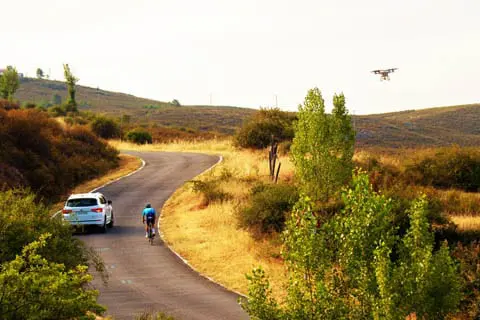IoT system includes drone imagery and real-time data processing
Spanish telecoms giant Telefónica, the Directorate General for Traffic (DGT) and Spanish car marker SEAT have presented two cases in which IoT technology is used to increase road safety by helping to reduce accidents on Spanish roads.
The aim of the project, carried out in Becerril de la Sierra (Madrid), is to show how an Internet of Things solution works in the early detection and warning of hazards to drivers travelling on a road with two specific cases that often cause situations of great danger: The presence of a cyclist riding along the same road, and the existence of a stationary car on the road due to a breakdown or some other type of incident.
The IoT system consists of a drone with a camera, which captures images of what is happening on the road and sends them in real time to a server that will soon be connected to the DGT 3.0 platform via Telefónica’s mobile network. The system processes the image, detects if there is a bicycle or a stationary vehicle on the road and sends an alert to the connected SEAT car.
The vehicle is connected to the network by a Telematic Control Unit (TCU), using Cellular Vehicle to Everything (C-V2X) technology through software that enables communication between the vehicle’s internal network and its surroundings.
“The result is that the connected cars travelling on that road and in the same direction in which the obstacle has been detected receive an alert that warns them of the danger they are going to encounter further on. This means that the driver can anticipate the problem and make decisions, having time to react, thus avoiding possible accidents,” Telefonica said in a release.
Telefónica has provided the project with end-to-end connectivity and has opened its network so that third parties can deploy applications on the edge of the network, enabling critical communications with immediate response such as traffic management.
At this year’s Mobile World Congress, Telefónica and SEAT presented several use cases for connected cars and assisted driving via 5G in a real environment, in which sensors installed in various infrastructures of the city of Barcelona warned the connected cars of the presence of pedestrians, cyclists and stationary vehicles on the roads.
“The DGT 3.0 platform keeps road users connected by informing them of real-time traffic status, diversions, reversible lanes, application of measures for pollution protocols, traffic restrictions, road works being carried out and any type of incident that may affect traffic circulation. Similarly, it can also send them alerts about the proximity of cyclists, the forecast of roadblocks or traffic jams as well as the risk of fog. All this information is of vital importance when it comes to improving road safety, particularly on secondary roads,” Telefonica said.
All this data will be exchanged between the drivers and the DGT intelligent platform anonymously with all the assurances in place to maintain users’ digital security, the telco added.

